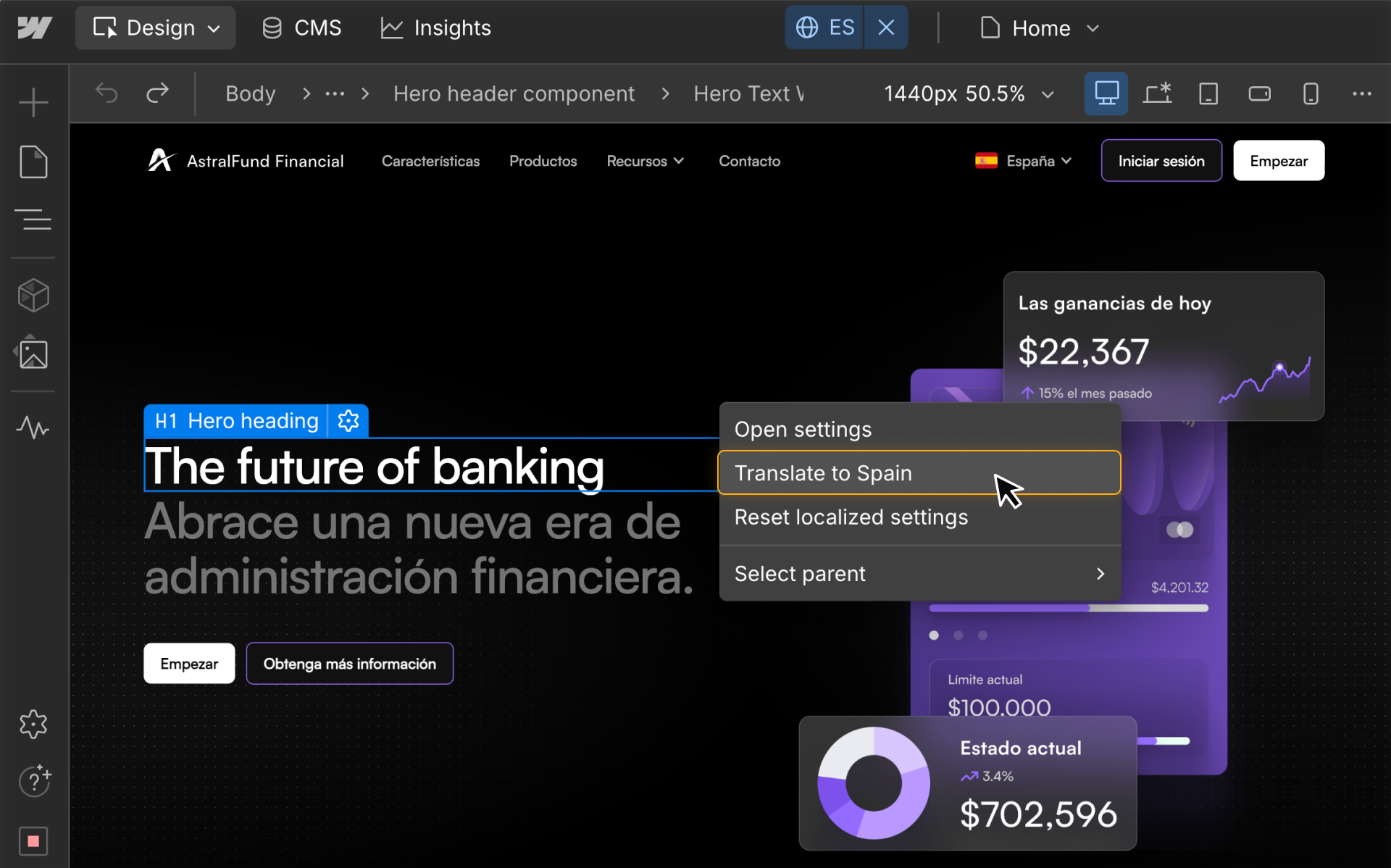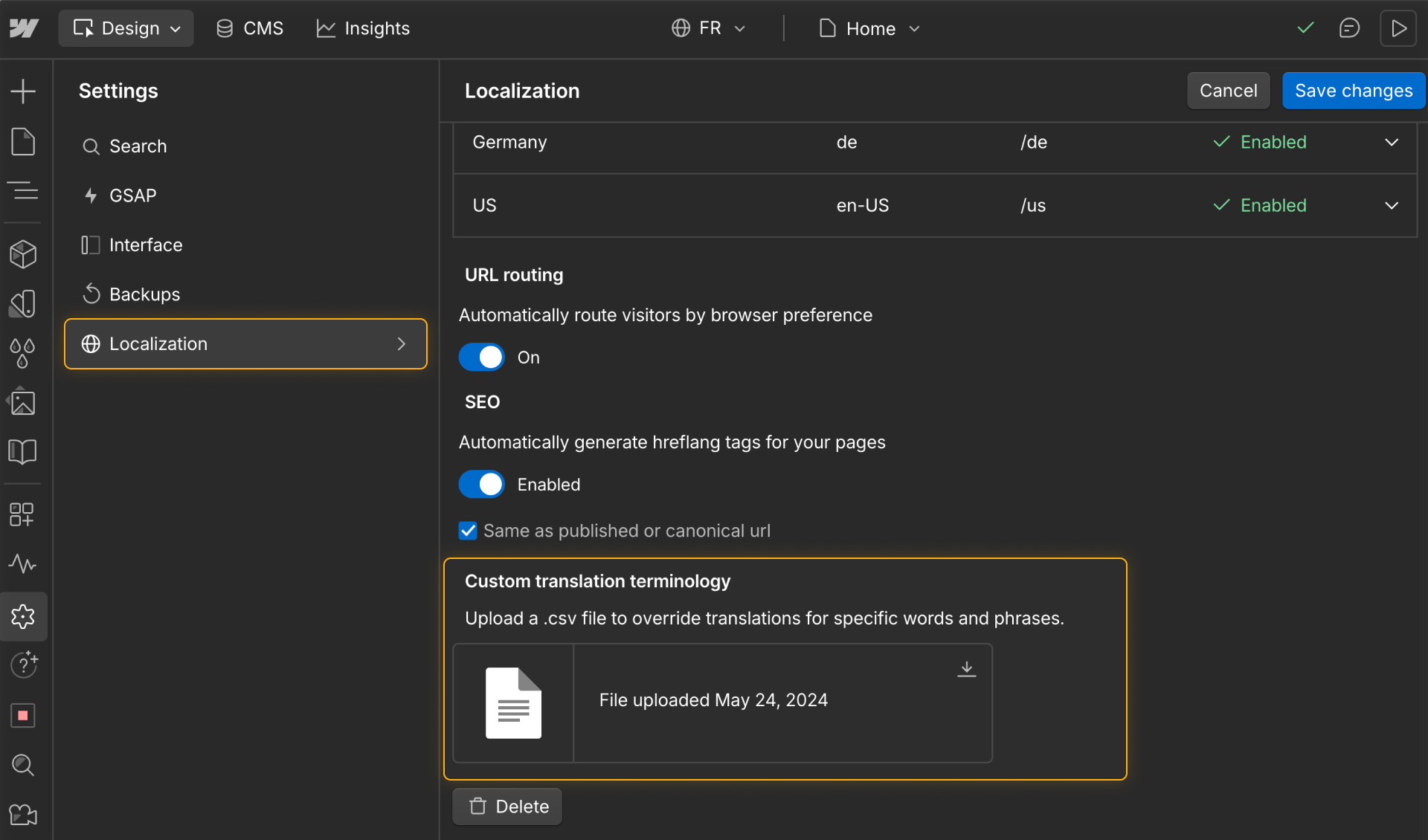Translation options: Manual, machine, or connected
Translation options
Once your locales are set up, the next step is translating your site’s content — from text blocks and buttons to CMS items and SEO metadata.
In Webflow, you can translate and localize your content in three main ways:
- Manually: Edit text directly on the canvas or in the CMS.
- Automatically: Use Webflow’s built-in machine-powered translation.
- Connected: Integrate with translation management systems (TMS) with Apps or APIs for advanced workflows.
Each approach offers a different level of control and efficiency. Let’s explore when to use each one.
Manual translation
Manual translation gives you complete control over tone, nuance, and phrasing. You can type directly into any text field, edit CMS items, or update SEO metadata and alt text per locale.
Use manual translation when you want to:
- Keep your brand voice consistent across languages
- Refine tone and context for each region
- Translate smaller sites or short, high-impact content (like CTAs and headlines)
- Adapt content for markets that share the same language but differ culturally or regionally
Manual translation isn’t limited to language differences — it’s also key for same-language localization. For example, when adapting U.S. English content for the U.K., you might update:
- Spelling (color → colour, organize → organise)
- Terminology (apartment → flat, vacation → holiday)
- Cultural references (sports, currency, measurements, imagery)
Even subtle regional adjustments help your content feel native and improve SEO and search intent alignment for that market.
Example: Translate your homepage headline manually so it captures the same tone and rhythm in each language, even if the literal words differ.
Machine translation
Webflow’s machine-powered translation helps you quickly translate large amounts of text without leaving the canvas. You can:
- Right-click an element to translate a single text block
- Right-click the Body element to instantly translate all static text on a page
- Click the globe icon in settings panels (like alt text or meta descriptions) to auto-translate those fields
- Translate CMS fields and items directly in the Webflow CMS using the globe icon — for example, translating a blog post’s title, summary, or rich text field at the item level

Use machine translation when you want to:
- Speed up your workflow and translate at scale
- Get a “first draft” translation to refine later
- Test new markets or quickly localize low-priority pages
Tip: Machine translation is ideal for scaling content quickly, but always review results for tone, accuracy, and cultural context.
Custom machine translation glossary
If you’re on a Webflow Localization Enterprise plan, you can add a custom machine translation glossary to lock specific terms like product names, brand phrases, or technical terminology to predefined translations.
This helps ensure accuracy and consistency for:
- Product or company names that should never be translated
- Industry-specific terms that must stay consistent
- Or UI phrases or CTAs with precise meanings

Note: Translation glossary is available on Localization Enterprise plans.
Connected workflows (Apps & APIs)
For larger teams or complex workflows, you may already use a translation management system (TMS) — software that helps organize, automate, and collaborate on translations across languages.
By connecting your TMS to Webflow Localization, you can:
- Collaborate with translators or localization agencies in one centralized workspace
- Sync translated content automatically across locales
- Maintain glossaries and brand terminology for accuracy and consistency
- Push and pull updates between systems without manual copy-paste
Connected workflows are ideal if you manage multiple locales or frequent content updates, need quality assurance and translation review steps, or already work with a dedicated translation partner or external language vendor.
You can connect to a TMS in two ways: Webflow Apps & Localization APIs
Webflow Apps for Localization
You can use Webflow Apps to connect directly to supported TMS providers like Lokalise, Smartling, or Phrase.
Apps handle setup for you, creating a seamless link between Webflow and your translation platform — ideal for teams that want an easy, no-code integration.
Visit the Webflow Apps Marketplace to explore available TMS integrations.
Localization APIs
For more flexibility, you can use Webflow’s Localization APIs to connect any TMS of your choice or build a custom workflow. APIs give you full control over how and when content is created, updated, and synced — great for technical teams or more advanced workflows.
Example: You can use the API to automatically push new CMS items from Webflow to your TMS and pull translated versions back in when ready.
See the Localization API documentation for details on endpoints and examples.
You can also use the Webflow MCP with Webflow’s APIs to speed up machine-powered translation and translate your site automatically. Check out the MCP developer documentation to learn more.
Strategy: Translation, localization, and transcreation
As your global strategy grows, it helps to understand three approaches to adapting content:
- Translation: Directly converts text from one language to another while preserving meaning and structure. Use this for straightforward content like FAQs, legal pages, or product specs.
- Localization: Adapts content for regional fluency and cultural relevance. Use this for UI copy, navigation, or marketing text that needs to feel natural in each language.
- Transcreation: Reimagines content to preserve tone, emotion, and brand voice — even if the words change completely. Use this for campaigns, headlines, and storytelling that need emotional impact.
You can mix these approaches. For example, start with machine translation, refine manually, and use transcreation for high-visibility content.
There’s no single “right” workflow. Your approach depends on team size, site scale, and content goals.
- If you’re a small team or solo designer, start with manual or machine translation.
- If you’re expanding into multiple regions, use a mix of both.
- If you’re a large brand or enterprise, connect to a TMS or use APIs to scale efficiently.
Tip: Learn more about translation, localization, and transcreation in our Localize text and SEO Webflow Way article.
Got it down?
Now that you know your translation options, let’s explore how Localization works with the Webflow CMS so you can manage and translate dynamic content across locales.